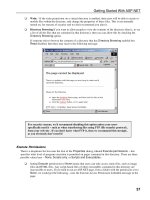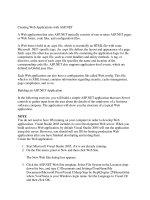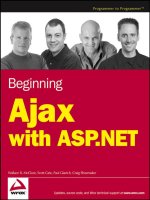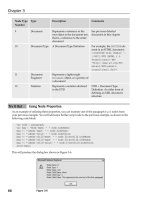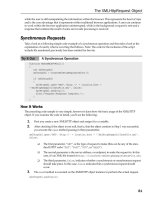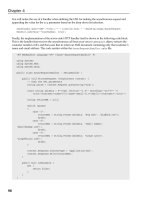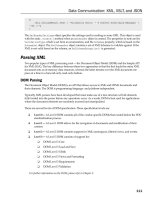Beginning Ajax with ASP.NET- P16 doc
Bạn đang xem bản rút gọn của tài liệu. Xem và tải ngay bản đầy đủ của tài liệu tại đây (406.81 KB, 15 trang )
The framework contains supporting code to trap events where the user clicks on a link that points to
another HTML document on the server. The click event is interrogated by the custom method, and if it con-
tains a “class” attribute that matches the format described previously (that is,
loadinto-{control_id}),
then an asynchronous operation is invoked to perform the document loading and subsequent dynamic
displaying on the web browser display.
Currently, this framework is ideally suited to constructing HTML pages using multiple content sources
located on a server and loaded in asynchronously so that links never actually cause a postback to occur.
As of this writing, experimental modifications allow
post-ing a form asynchronously to a server and
receiving a result, which is also dynamically displayed. This is, however, not fully tested and is a work
in progress.
If the display of an HTML file using dynamic and asynchronous behavior is desired, then this library
can be easily and effectively used to achieve that. If access to specific server-side services is required
above and beyond that of simple HTML document display, then this library may not be the ideal choice.
If nothing else, the ability of this library to capture events easily can be used to perform any number of
tasks not currently offered by the framework.
MochiKit
URL:
MochiKit is a client-side JavaScript framework or more specifically, a suite of JavaScript libraries. MochiKit
is described as (taken from the web site itself) a suite of JavaScript libraries that “make JavaScript suck
less.” The aim of the MochiKit framework is to make programming in JavaScript a lot easier and, like
many of the other client-side-only libraries, provide a layer of abstraction between raw coding details
that are specific to each browser. This allows a common method of accessing objects and functions, such
as Ajax asynchronous functionality, without having to code specific implementations for all the browsers
you are required to support in your development efforts.
MochiKit is quite a comprehensive framework and contains a large amount of functionality that extends
asynchronous behavior. Broadly speaking, MochiKit covers the following areas:
❑ Asynchronous requests
❑ Low-level functional and comparison features
❑ DOM manipulation
❑ Color and style manipulation with CSS3 (Cascading Style Sheets) support
❑ Date and time formatting and parsing routines
❑ String formatting routines
❑ Logging features and supporting an API
❑ Specialized Logging Pane to aid in tracing and debugging
❑ Visual effects library
❑ Iteration support API
201
Other Ajax Frameworks for .NET
12_78544X ch09.qxp 7/18/06 3:16 PM Page 201
Each one of the areas listed is contained within a separate module of the MochiKit framework. Simplicity
is a key goal with this framework and some examples best demonstrate this:
var x = getXMLHttpRequest();
The preceding code will simply return an object that is the equivalent XMLHttpRequest object for the
particular platform (that is, browser type):
var d = loadJSONDoc(url):
This code will perform an asynchronous request to the specified URL location and retrieve the response
as a JSON-formatted document. JSON is an acronym for the JavaScript Object Notation and is a stan-
dard, lightweight way of representing objects using a string format. JavaScript natively understands this
format and can evaluate a string that is in JSON format using the
eval method to return a valid object.
The
loadJSONDoc method shown in the preceding code line returns an object that is of type Deferred.
The
Deferred object is a special type provided by the MochiKit library. Deferred type objects are a way
of abstracting nonblocking events, such as the final response to an
XMLHttpRequest. These allow the
addition of callback functions to the
Deferred objects collection that are called when an asynchronous
operation completes. The complete code might look like this:
var d = loadJSONDoc(“ />var gotMetadata = function (meta) {
alert(“JSON document loaded ok.”);
};
var metadataFetchFailed = function (err) {
alert(“The document could not be fetched.”);
};
d.addCallbacks(gotMetadata, metadataFetchFailed);
The first line of the preceding example:
var d = loadJSONDoc(“ />simply instructs the MochiKit library to asynchronously load the document specified and returns an
instance of an object that is of type
Deferred. The next two lines define functions that you want to be
called when the document loads successfully and when an error occurs, respectively.
var gotMetadata = function (meta) {
alert(“JSON document loaded ok.”);
};
var metadataFetchFailed = function (err) {
alert(“The document could not be fetched.”);
};
It is then a matter of attaching these functions to the Deferred object that is returned using the syntax:
d.addCallbacks(gotMetadata, metadataFetchFailed);
The Deferred object is a fundamental part of the MochiKit framework and provides much more exten-
sive functionality than what has been listed here to support a wide variety of asynchronous operations,
202
Chapter 9
12_78544X ch09.qxp 7/18/06 3:16 PM Page 202
locking, synchronization, callbacks, and so on. In many ways, the Deferred object provides similar fea-
tures, or at least provides a similar function, to delegates within the .NET framework.
In addition to support for asynchronous behavior, MochiKit also contains support for some basic visual
effects. At this time, MochiKit provides one visual effect: rounded corners for your HTML elements. These
rounded corners are created completely through CSS manipulations and require no external images or
style sheets. This is performed by calling either of the two methods,
roundClass or roundElement. The
former rounds all of the elements that match the supplied
tagName and className arguments, and
the latter immediately rounds the corners of the specified element.
MochiKit provides a good abstraction around some of the complexities and drudgery of JavaScript
coding and is continually undergoing enhancement and change. It is a well-documented library, with
provision for unit tests and extensive API reference documentation. This alone makes it a framework
worth considering and evaluating for client-side development that seems to succeed in its mission of
“making JavaScript suck less.”
Server-Side Frameworks
While the client side frameworks have their obvious advantages as an ASP.NET developer you may find
yourself wanting to work with a framework that is tailor-made for the ASP.NET world. The following
discussion will briefly explain the differences between three server-side frameworks and give you an
opportunity to work directly with each one.
Architectural Distinctions
Every software architect tries to solve the same problems using a different approach. An Ajax-enabled
page will not only use the
XmlHttpRequest object but will also need to alter the rendered page to
update the user interface. Each library highlighted in this section is chosen for the varying ways the
framework developers tried to create an abstraction layer around the lower-level Ajax technologies.
Creating Ajax applications can be taxing on a developer. JavaScript is an integral part of Ajax develop-
ment and is not supported in the same way as server-side languages. While some programmers have
limited skills in JavaScript, even seasoned developers do not have the luxury of full integrated develop-
ment environment (IDE) integration, powerful debugging tools, and unit-testing support. The creators
of the various Ajax frameworks have addressed this challenge by architecting their frameworks to mini-
mize the need for manual JavaScript coding. In fact, some frameworks allow you to develop full Ajax
applications without writing one line of JavaScript; while this is attractive, each benefit comes with its
own tradeoff.
Some frameworks require you to inherit from a base class; others give you the option or have no require-
ment at all. Some frameworks wrap up Ajax functionality by abstracting all JavaScript calls to the server;
others allow you to use JavaScript to directly invoke server methods.
How do you remove JavaScript from the equation? Ajax is dependent on the
XmlHttpRequest object,
which exists only on the web browser, so how is this possible?
The answer lies in how the application deals with data and how the user interface is updated.
203
Other Ajax Frameworks for .NET
12_78544X ch09.qxp 7/18/06 3:16 PM Page 203
Data Structures versus Changed HTML
Ajax frameworks may be categorized in many ways, but one way to distinguish them is to look at what
type of data is returned to the browser. Some Ajax frameworks will return data structures and others
will return only changed HTML.
The idea behind the two different approaches lies in the use of JavaScript. A framework that returns data
structures to the client will require the browser to “do something” with that data. Often the browser will
glue the data to the existing HTML structure on the page using the DOM.
Some developers would rather stay away from working with JavaScript directly and return to the
browser only the changes in HTML. This technique removes the need for intensive JavaScript parsing
of the DOM and the need to write JavaScript manually. Another benefit of this approach is that the stan-
dard ASP.NET page event lifecycle may be preserved.
Ajax.NET and Atlas return JavaScript Object Notation (JSON) data structures to the client, whereas
ComfortASP.NET and MagicAjax return only changed HTML. Anthem.NET gives you the option work-
ing manually with JSON objects or simply serving back to the browser what is changed in the HTML.
Benefits
The benefit of working with data structures is that you have complete power and control over your data.
Should you choose to return a block of data to the client and render the same information a number of
different ways, you may do so. The availability of data structures also allows you to manipulate data in
ways that are not available to you in a strict code-behind setup. If you want to make an Ajax call when
the focus is lost on a control, having a package that returns data structures where you can write custom
functions to manipulate your data is not only desirable but also required.
HTML-only solutions are nice because they truly make Ajax development effortless. When all you have
to do is define some controls on your page and then in code-behind manipulate the controls the same
way you would if there was a postback, the learning curve is drastically shortened. Solutions that will
return changed HTML to the browser also often do not require the writing of any manual JavaScript.
This is desirable because now you do not have to worry about maintaining client-side code.
Drawbacks
The drawbacks may seem obvious, but when you have a framework that returns data structures you
will often have to write and maintain your own JavaScript code.
The disadvantage to frameworks that offer a changed HTML-only architecture is that should you need
to manipulate your data in such a way that is not native to an ASP.NET control, you will have no way to
hook into the framework. For example, in ComfortASP.NET there is no way for you to call a server-side
method when the focus leaves a control. The architectural structure of this library is designed to keep
development as close to the way you would code if the page were still operating under the traditional
ASP.NET postback model.
Anthem.NET is unique in this regard because you have the option of returning data
structures or changed HTML.
204
Chapter 9
12_78544X ch09.qxp 7/18/06 3:16 PM Page 204
Panels versus Custom Controls
Once the server has finalized its processing and has returned a response to the client, the application
must have a way of determining what part of the HTML page to update. The two methods you find in
the frameworks in this section use either panels or custom controls.
When you think of an “Ajax panel” think along the same lines as the ASP.NET
Panel control. When using
this control, you create a container on the page where other controls placed inside the container may be
dealt with as a group. For example if you make the panel invisible, all the child controls are invisible.
The panels used in the Ajax libraries function in much the same way. When you define an Ajax panel on
your page, you are automatically given the ability to update the panel’s child control attributes without
requiring the page to conduct a full postback. All three frameworks feature panels in their architecture.
The other method of letting the browser know what to update is to use custom controls. Instead of
wrapping your controls in some sort of container, you may declaratively add Ajax controls to the page.
These controls are then recognized by the host framework and are given the Ajax capabilities. Custom
controls are an integral part of the Anthem.NET framework.
Benefits
The benefits of a paneled architecture are most apparent in ease of use. When using panels, most of the
hard work of creating Ajax solutions is managed by the code the panel creates for a developer. Perhaps
the greatest benefit to using panels is that you may deal with controls as a group; you are not required
to touch each control just to give it the behavior you desire. Panels bring flexibility to your page.
Custom controls bring an alternate set of benefits. Since a custom control is specific for each control on
the page, you will have a richer set of features available to you. Anthem.NET adds a variety of custom
properties, events, and methods to its custom controls. The primary benefit of custom controls is the
fine-grained control over a page.
Drawbacks
The downside to using panels is that you will not have as much control over the controls on your page.
This method’s advantage may be a disadvantage, depending on your situation.
The disadvantages of using custom controls are twofold:
❑ The first drawback is that there is sometimes not a one-to-one relationship between ASP.NET
controls and the custom controls of the framework. For instance, as of this printing Anthem.NET
does not feature an equivalent control for the ASP.NET 2.0
DetailsView control.
❑ The other disadvantage is that when using custom controls you are, by nature, forced to replace
the native ASP.NET controls with your library’s controls. This may or may not be a problem
depending on your situation.
Configuration Options
Each framework requires you to configure your application a little bit differently. The different configura-
tion approaches found among the featured frameworks include using
httpHandlers or httpModules,
inheriting your ASP.NET page from the library’s base page class, or using page control directives.
205
Other Ajax Frameworks for .NET
12_78544X ch09.qxp 7/18/06 3:16 PM Page 205
❑ The use of an httpHandler or httpModule is similar in the respect that ASP.NET will process
the requests through either the handler or module before allowing the page to execute. To
signify this distinction, from now on we will refer to the use of either an
httpHandler or
httpModule as “preprocessing.” Preprocessing provides a layer where the application will
examine requests coming to the server to determine if any Ajax support is required to render
to the page. Preprocessing configuration options are not enough alone to grant a page Ajax sup-
port, but less work is required on a page level.
❑ Some frameworks have a base page class that you inherit your ASP.NET web forms from instead
of the traditional
System.Web.UI.Page class. The custom base class will encapsulate the required
plumbing that your page needs to handle Ajax interaction between the client and server.
❑ The final option is to use a page control directive. These directives allow you to declaratively
add Ajax support to a page at design time. The page control directive can supersede the need
for preprocessing or the use of a base page class.
You will see each of these options implemented in coming examples.
Benefits
Preprocessing allows each page in your application the ability to cycle through your Ajax engine. This
can make turning on Ajax features of a page easier because there is less code you must write on the
page level.
Base classes give you all the benefits of inheritance by giving your page Ajax processing support “for free.”
The base class will often include useful services that make coding easier, but the true benefit is found in ease
of use. Often frameworks that provide a base class require very little extra coding to create an Ajax experi-
ence. Another benefit to using a base class lies in the fact that you may inherit from the class. This extra layer
of abstraction allows you to make changes and provide services to your Ajax pages in one place.
Page control directives perhaps give you the best of both worlds, because you will avoid the disadvan-
tages (stated in the following section) of the preprocessing and base class options, while still giving your
page full Ajax support.
Drawbacks
In some experiments with frameworks that use preprocessing, we have found a few cases where the Ajax
httpHandler or httpModule interfered with applications that used their own custom handler or mod-
ule. The preprocessing configuration may not be the best option for you if you are working on a project
that already employs its own handlers or modules. Test rigorously to ensure a true working solution.
The drawbacks to base classes are classic in object-oriented development. If want to use a solution that
requires you inherit from the base class, you may run into a few problems. What if you are already inher-
iting from your own base class? The .NET runtime does not support multiple inheritances, so you must
then make a choice; do you keep your base class or go with the base class from the third-party frame-
work? Other questions you might pose to yourself are: What if I change Ajax libraries? What will that
to do my inheritance structure? Although base classes at first may seem attractive, implementation by
inheritance, rather than composition may often architecturally limit you in the end.
Page control directives are nice because they are a light-touch addition to your page. However, since you
are not inheriting from the control, making global changes becomes more difficult. If you wanted to add
206
Chapter 9
12_78544X ch09.qxp 7/18/06 3:16 PM Page 206
custom logic to the directive control, you would have to inherit from the Ajax control and create your
own control exposing it as a page directive control.
Creating Your Resource Data File
Before you begin implementing the coming examples, there is a file you must create that will give your
applications some sample data. This file is an XML structure that will allow you to conduct data binding
without having to worry about connecting up to a database.
1. Open Visual Studio.NET 2005.
2. Press Ctrl+N to display the New File dialog box.
3. Click XML file template.
4. Click the Open button.
5. Enter the following code:
Resources.xml
<?xml version=”1.0” encoding=”utf-8”?>
<resources>
<resource>
<title>Polymorphic Podcast</title>
<url> /><author>Craig Shoemaker</author>
</resource>
<resource>
<title>ASP.NET Podcast</title>
<url> /><author>Wally McClure</author>
</resource>
<resource>
<title>Glavs Blog : The dotDude of .Net</title>
<url> /><author>Paul Glavich</author>
</resource>
<resource>
<title>Scott Cate Weblog</title>
<url> /><author>Scott Cate</author>
</resource>
</resources>
6. Press Ctrl+S to save the file.
7. Save the file to C:\BeginningAJAX\Chapter9\Resources.xml.
Introduction to the Frameworks
The following examples will highlight different features from the ComfortASP.NET, MagicAjax, and
Anthem.NET frameworks. While learning about each framework, keep in mind the type of development
that you do and which solution best fits your needs.
207
Other Ajax Frameworks for .NET
12_78544X ch09.qxp 7/18/06 3:16 PM Page 207
Each library employs a number of the architectural distinctions presented earlier in this section. The
introductory sections will familiarize you with the framework and describe the options available in each
framework. The examples begin with the traditional “Hello World” implementation, and then proceed
to more in-depth samples. Some demonstrations are repeated between the frameworks. The repetition is
included by design to illustrate how the same problems are addressed by the different libraries.
ComfortASP.NET
URL: www.comfortasp.de
ComfortASP.NET is a framework that allows you to quickly Ajax-enable any ASP.NET page. A demo ver-
sion of the software is all that is needed for the following examples. You may download ComfortASP.NET
from
For more information about
ComfortASP.NET, please visit the official web site at
www.comfortasp.de.
ComfortASP.NET’s architecture is flexible and gives a developer a number of different ways to configure
the application. The framework employs a changed HTML-only architecture, uses panels, and gives you
the option of either using preprocessing or a base page class.
In the coming examples, you will use ComfortASP.NET’s base page class. When the base class is config-
ured properly, you may code your page normally, and the framework will worry about the Ajax imple-
mentation details. What’s surprising about this framework is that the only configuration required of the
base class is to set the
HiddenFormPostBack property to true.
Optionally, ComfortASP.NET will save the page and
ViewState information in session. Using session
state allows the framework to quickly serve pages back to the client because it uses the information per-
sisted in session rather than asking the server to build up the page again. Session use is optional and
may or may not be desirable, depending on the application you are building.
Data transferred between the client and server may also be compressed by ComfortASP.NET. The
CompressionLevel property of a ComfortASP.NET Manager control determines the amount of com-
pression applied to the transporting data. The compression scale ranges from 1 to 9. At the low end of
the spectrum, there is little compression with higher transfer speeds. The higher end of the spectrum is
more data compression, resulting in lower transmission speeds.
Setup
Before you begin using the ComfortASP.NET framework, you must first download the files and then ref-
erence them in a web project. The following steps help you build a solution that houses all the samples
you create for the ComfortASP.NET framework.
Downloading Files
1. Download the zip file containing the ComfortASP.NET DLL file from http://beginning
ajax.com/downloads/chapter9/Chapter9-Framework DLLs.zip.
2. Extract the files and place them in a convenient location.
208
Chapter 9
12_78544X ch09.qxp 7/18/06 3:16 PM Page 208
Creating the Solution
1. Open Visual Studio 2005.
2. Click File➪New➪Website.
3. Select the ASP.NET Website template.
4. Choose File System under location.
5. Set the path to c:\BeginningAJAX\Chapter9\ComfortASPDemo.
6. Choose C# as the language.
7. Click OK.
Referencing ComfortASP.NET
1. In the Solution Explorer, right-click on the project name and select Add ASP.NET Folder.
2. Choose App_LocalResources to create the ASP.NET folder.
3. Copy ComfortASP.dll (from the zip file you extracted) to the App_LocalResource folder.
4. Create a reference to ComfortASP.dll.
Copying the Data File
1. Copy the Resources.xml you created in the last section into the App_Data folder in the solution.
Adding the ComfortASP.NET Group to the Toolbox
ComfortASP.NET comes with some controls that can be used to create specific behaviors. To use these
controls in the Visual Studio Designer, you must add them into the Toolbox:
1. Right-click on the Toolbox window, and select Add Tab.
2. Name the tab ComfortASP.NET.
3. Left-click the ComfortASP.NET tab.
4. Right-click ComfortASP.NET.
5. Select Choose Items.
6. Click Browse and select ComfortASP.dll from the location you placed it in the earlier steps.
7. The new controls are automatically selected —click OK.
You may now begin implementing your first Ajax pages using the ComfortASP.NET framework.
Using ComfortASP.NET
Now that the project is configured to work with the ComfortASP.NET framework, you may begin work-
ing hands-on with the framework. The next few sections will walk you through building pages that
implement an introductory example, highlight some of the features unique to ComfortASP.NET, and
explain how to execute some common operations using the framework.
209
Other Ajax Frameworks for .NET
12_78544X ch09.qxp 7/18/06 3:16 PM Page 209
Example 1: Hello World
The first exercise will take you step by step through creating a Hello World page. In the coming examples,
the interaction between the client and server is handled by subclassing ComfortASP.NET’s base page
class. To Ajax-enable the page, you simply switch on the page’s
HiddenFormPostBack property and the
rest of the code-behind remains unchanged from the code used in the traditional postback paradigm.
Figure 9-1 is a screenshot of what the page looks like once it’s constructed.
Figure 9-1
When you click on the Test button, the label is updated with the words “Hello World” plus the current
date and time.
Try It Out Implementing “Hello World”
Add a new web form to the solution and name it HelloWorld.aspx. Open the HTML editor, and enter
the following markup between the
<div> tags:
<asp:Button
ID=”btnTest”
Text=”Test”
runat=”server” />
210
Chapter 9
12_78544X ch09.qxp 7/18/06 3:16 PM Page 210
<asp:Label
ID=”lblTest”
runat=”server” />
Note that the HTML markup is exactly the same as if the page were not using ComfortASP.NET.
Switch to the designer view, and double-click the Test button. This will wire up a click event method to
the button and switch you to the code-behind window.
Next, update the
HelloWorld class to inherit from ComfortASP.ComfortASP_Page:
public partial class HelloWorld : ComfortASP.ComfortASP_Page
{
protected void Page_Load(object sender, EventArgs e)
{
this.HiddenFormPostBack = true;
}
protected void btnTest_Click(object sender, EventArgs e)
{
this.lblTest.Text = “Hello World “ + DateTime.Now.ToString();
}
}
The Page_Load event method will set the HiddenFormPostBack property equal to true, enabling
ComfortASP.NET on the page. In the button click event, update the text of the label to print Hello World
and current date and time for the user.
Now you may launch the application in the browser to test your code. Click the Test button, and you
will notice that the label is updated. Click the button again, and you can observe that no postbacks are
taking place and the time will be updated with each click.
Example 2: Using Complex Controls
You see now that working with ComfortASP.NET is easy, but what about when you want to use more
complex controls like the ASP.NET
GridView control? Databound controls like the ASP.NET GridView
have a much larger property set as well as custom events. ComfortASP.NET can make developing with
these controls just as easy as the Hello World example above.
This example will bind the contents of the
Resources.xml file to a GridView control. When the user clicks
on an item in the grid, the
SelectedIndexChanged event will fire to update the page, notifying the user of
the new selected index. The purpose of this demonstration is to show you that the ComfortASP.NET frame-
work makes working with controls that have custom events and extended properties just as easy as the
previous Hello World example.
Figure 9-2 shows what the page will look like when you are done.
When you click the Load Resource button, the grid is loaded with data. When you click an item in the
grid, the new selected index is printed on the page.
211
Other Ajax Frameworks for .NET
12_78544X ch09.qxp 7/18/06 3:16 PM Page 211
Figure 9-2
Try It Out Using Complex Controls
Add a new web form to the solution and call it ComplexControls.aspx. Switch to the source view and
add the following markup between the
<div> tags.
<asp:Button
ID=”btnLoadResources”
OnClick=”btnLoadResources_Click”
Text=”Load Resources”
runat=”server” />
<asp:gridview
ID=”grdResources”
runat=”server”
OnSelectedIndexChanged=”grdResources_SelectedIndexChanged”>
<Columns>
<asp:CommandField ShowSelectButton=”True” />
</Columns>
</asp:gridview>
<p>Selected index:
<asp:Label ID=”lblSelectedIndex” runat=”server” /></p>
212
Chapter 9
12_78544X ch09.qxp 7/18/06 3:16 PM Page 212
Switch to the source window to update the ComplexControls class.
public partial class ComplexControls : ComfortASP.ComfortASP_Page
{
protected void Page_Load(object sender, EventArgs e)
{
this.HiddenFormPostBack = true;
}
protected void btnLoadResources_Click(object sender, EventArgs e)
{
System.Data.DataSet ds;
ds = new System.Data.DataSet();
ds.ReadXml(Server.MapPath(“~/App_Data/Resources.xml”));
this.grdResources.DataSource = ds;
this.grdResources.DataBind();
}
protected void grdResources_SelectedIndexChanged(object sender, EventArgs e)
{
this.lblSelectedIndex.Text =
this.grdResources.SelectedIndex.ToString();
}
}
The page will inherit from the ComfortASP.NET base page and will turn on the HiddenFormPostBack
property in the Page_Load method. When the Load Resources button is clicked, you will load the data
from the
Resources.xml file and bind it to the GridView control. Finally, when an item in the grid is
selected, the
SelectedIndex is printed to the lblSelectedIndex label on the page.
You can now launch the application in the browser to test your code.
Example 3: ComfortASP.NET Manager Control
The ComfortASP.NET Manager control gives you a centralized place to administer the page’s Ajax capa-
bilities. The manager control provides services that implement many common requirements. We will
review some of the more common features of the control here, but please refer to the ComfortASP.NET
web site for full documentation of the
Manager control.
If you want to stop a user from repeatedly clicking on a button that initiates an Ajax call, you might
choose to disable the button once the call is dispatched. ComfortASP.NET makes it easy to disable these
controls. The manager’s
DisableFormWhilePostBack property will automate this process of enabling
or disabling the controls on a page during a callback to the server. If the property is set to
true, then all
controls are disabled during an Ajax call; otherwise, the controls are left alone.
Ajax applications face the challenge that the server will not always respond in a timely manner. Consider
what the user would think when he or she clicks a button and nothing happens on the page for well over
a minute, or perhaps never. The ComfortASP.NET
Manager control has a built-in safeguard against this
situation. The
HiddenRequestTimeout property will define the number of seconds the page should wait
213
Other Ajax Frameworks for .NET
12_78544X ch09.qxp 7/18/06 3:16 PM Page 213
until sending a notification that the request has timed out. The user may then decide whether or not to try
the request again. The
Manager control also exposes a property that will allow you to customize the mes-
sage displayed to the user in the event of a timeout.
The
TransferDifference property will determine if the entire page markup is returned to the client or
if just the changed section of the page goes across the wire. The distinction between the two options lies
in the use of session state. If you do not want ComfortASP.NET to use session state to persist the page
contents, then
TransferDifference is false. Alternatively, if you allow the framework to use session
to hold page content, then
TransferDifference is set to true.
Figure 9-3 shows an example of the “loading” message generated by the ComfortASP.NET framework
when the server is engaged in processing. Also notice how the button is disabled. This behavior is imple-
mented by changing some of the values on the ComfortASP.NET
Manager control.
Figure 9-3
Figure 9-4 is an example of how the user is notified when a request timeout occurs.
214
Chapter 9
12_78544X ch09.qxp 7/18/06 3:16 PM Page 214
Figure 9-4
Try It Out Using the Control Manager
Add a new web form to the solution and name it Manager.aspx. Make sure that the ASPX page is in
design view, and hover over the toolbar to drag a ComfortASP.NET
Manager control onto the page.
Switch to source view, and add the following markup.
The ComfortASP.NET
Manager control is already added to your page; simply adjust the property values
to match what is listed here, and add the markup for the button and label.
<cc1:ComfortASP_Manager
ID=”comfortManager”
HiddenRequestTimeout=”20”
HiddenRequestTimeoutText=”The server is busy. Try again?”
DisableFormWhilePostBack=”True”
TransferDifference=”True”
runat=”server” />
<asp:Button
ID=”btnLongRequest”
Text=”Simulate Long Server Request”
runat=”server” />
<asp:Label
ID=”lblResult”
runat=”server” />
215
Other Ajax Frameworks for .NET
12_78544X ch09.qxp 7/18/06 3:16 PM Page 215
